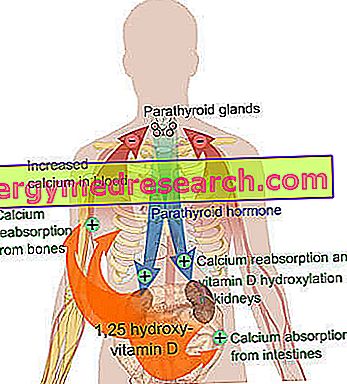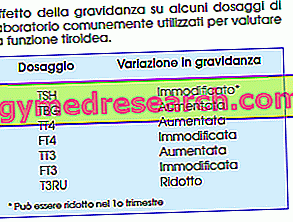Generality
The term calcemia indicates the concentration of calcium in the blood, where this mineral is found partly in free form and partly linked to plasma proteins, such as albumin (80%) and globulins (20%). Generally, the overall concentration of both forms is evaluated, the so-called total calcemia, to which the two fractions contribute in roughly equal parts.

What's this
Calcium measures the concentration of calcium in the blood.
Calcium is one of the body's most important minerals and is 99% stored in the bones. Almost all the remaining mineral circulates in the blood, where it can be present in free form or bound to plasma proteins.
The absorption, use and excretion of calcium are regulated and stabilized by a feedback mechanism (feed-back) involving parathormone (PTH), calcitonin and vitamin D.
Pathologies and conditions that interfere with the metabolism of calcium can cause inappropriate increases or decreases, acute or chronic, in calcium in the blood, leading to symptoms of hypercalcaemia or hypocalcemia.
The determination of the calcemia is performed:
- As part of the metabolic panel;
- When the patient develops symptoms of increased or decreased calcium concentrations, or has a condition that affects the kidneys, bones, nerves, thyroid or parathyroid glands;
- To evaluate the efficacy of a treatment for abnormal calcium concentrations.
Football functions
In the body, about 99% of calcium is found deposited in bones, nails and teeth, while the remaining portion is found in tissues and intravascular fluids.
In addition to guaranteeing the solidity of the skeletal system, calcium is essential for the normal functioning of muscles, heart, nerves and the endocrine system, as well as intervening in blood coagulation and participating in numerous enzymatic reactions; only the free fraction (ionized calcium) is directly active in this sense.
Regulation of Calcemia

In response to low calcium levels, parathyroid secretion produced by parathyroid glands increases. This hormone increases the mobilization of calcium from the bones, the intestinal absorption of calcium (favoring the activation of Vit. D at the renal level) and the renal reabsorption of calcium.
The consequent increase in calcemia leads to a reduction in parathyroid secretion.
The calcemia is maintained at relatively constant values (about 10 mg / dl) by the combined action of two hormones, the parathormone and the calcitonin, as well as by activated vitamin D ; to all this is added the contribution of food intake and daily urinary and faecal losses.
Thanks to these hormones and vitamin D:
- When blood calcium concentrations decrease ( hypocalcemia ), the bones release the mineral, increase the intestinal absorption of the same and decrease its urinary excretion;
- When calcemia rises excessively ( hypercalcemia ) calcium is deposited in the bones, excreted more easily and absorbed to a lesser extent.
This is an extremely effective regulatory mechanism, mostly independent of food revenues; however, just to avoid that calcemia is kept constant at the expense of a continuous depletion of bone deposits, it is very important to take the right amounts of calcium every day.
parathyroid | CALCITONIN | VITAMIN D |
Produced by parathyroids | Produced by the thyroid | Introduced with food |
Activates vitamin D at the kidney level, promoting intestinal calcium absorption; mobilizes calcium from bones and increases urinary phosphate elimination, increasing serum calcium. It stimulates the activity of osteoclasts. | It is secreted when the calcemia rises excessively, deposits calcium in the bones and increases renal reabsorption. It stimulates the activity of osteoblasts. | Also synthesized in the skin and activated by the kidney; has a synergistic action to that of the parathormone and antagonist to that of the calcitonin. |
In addition, other hormones participate in the metabolism of calcium :
- Glucocorticoids, for example, increase bone resorption and this is why chronic therapy with cortisone is typically accompanied by bone demineralization;
- Androgens and estrogens, on the other hand, have a protective effect against osteoporosis (it is no coincidence that the disease is typical of old age and post-menopause in women).
Despite the importance of calcium for bone health, calcemia is also detected to investigate the origin of symptoms related to various diseases, such as kidney or parathyroid diseases.
Why do you measure
Calcemia measures the levels of calcium present in the bloodstream. This evaluation is indicated as part of the routine examinations, but it can also be prescribed to facilitate the diagnosis and follow the progress of some pathologies, such as nephropathies or parathyroid diseases.
The doctor, therefore, prescribes the measurement of calcemia in the presence of symptoms that indicate an altered calcium metabolism.
When the doctor prescribes the serum calcium test, it generally requires the measurement of the total calcium, ie both the free form and the bound form (the test is easier to perform than the measurement of the mineral in the form of an ion).
In some situations, such as during surgery requiring blood transfusions, the determination of free calcium may also be required.
Alterations in the blood concentration of calcium, both in excess (hypercalcemia) and in defect (hypocalcemia), determine a series of symptoms, which in extreme situations can become particularly serious:
- Effects of hypocalcemia :
- Tetania (intermittent muscle cramps);
- Cardiac hyperexcitability (cardiac rhythm abnormalities);
- Bronchial, bladder, intestinal and vascular spasms.
- Tingling in my fingers.
- Effects of hypercalcaemia :
- Reduction of muscular and nervous excitability;
- Nausea;
- He retched;
- Constipation;
- Weakness;
- Loss of appetite;
- Abdominal pains;
- Frequent urination;
- Increased thirst;
- Kidney stones.
When the calcemia is abnormal, or in case of suspected kidney stones, the doctor may also indicate the measurement of calcium in the urine ( calciuria ). This exam indicates how much calcium is eliminated by the kidneys.
Changes in urinary calcium concentrations are associated with the same pathological conditions that affect serum calcium.
To have a more complete picture, then, the doctor can compare the results of the calcemia test with those of other blood tests, in particular, with the evaluations of:
- Parathormone and vitamin D, substances involved in maintaining calcium balance;
- Albumin, the main plasma protein that binds calcium;
- Phosphorus;
- Magnesium.
Calcemia does not reflect the concentration of the mineral in the bones, but indicates the amount of calcium circulating in the blood.
To determine bone density and related calcium concentrations there is a test similar to a radiograph, called bone densitometry or MOC.
Normal values
REFERENCE VALUES*
- Total serum in the child: 9-11 mg / dl
- Total serum in the adult: 9-10.7 mg / dl
* may vary slightly depending on the bibliographical source and from laboratory to laboratory. The values must also be corrected in relation to the level of albumin in the blood, according to the formula:
Correct total serum calcium = Total measured serum calcium + [(4.0 - albuminemia g / dL) * 0.8]
The measurement of calcemia must be performed on an empty stomach.
High Calcemia - Causes
Hypercalcemia is defined as an increase in calcium levels in the blood compared to the norm.
Usually, this condition is consequent to an excessive bone reabsorption; the most common causes include:
- Hyperparathyroidism (increased parathyroid gland function, usually due to benign tumors, with increased parathormone blood levels);
- Vitamin D intoxication (especially due to inadequate or excessive intake)
- Malignant tumors with bone metastases (in particular, breast cancer, lung and renal cancer, hematological malignancies such as multiple myeloma, leukemia and lymphoma).
Other possible reasons for the increase in blood calcium concentration include:
- Infections and inflammatory processes;
- Hyperthyroidism (increased thyroid function);
- High-protein diet;
- Kidney failure;
- Endocrine dysfunctions (Addison's disease and myxedema);
- Aluminum poisoning;
- Bone fractures combined with prolonged immobilization;
- Paget's disease of bones;
- Vitamin A intoxication;
- drugs:
- Some diuretics (thiazides), overdose of thyroid hormones (Eutirox), theophylline intoxication, tamoxifen therapy and excess lithium (used mainly in the treatment of bipolar disorder).
Hypercalcemia can also be the result of excessive absorption and / or gastro-intestinal calcium intake; this is the case of sarcoidosis and other granulomatous diseases (including berylliosis, histoplasmosis, leprosy, silicosis and tuberculosis).
Prolonged or severe hypercalcaemia can lead to nephrocalcinosis (precipitation of calcium salts inside the renal parenchyma) and renal failure.
Low Calcemia - Causes
Hypocalcaemia can depend on numerous causes, which include:
- Hypoparathyroidism (poor activity of hereditary or acquired parathyroid glands);
- Resistance to the effects of parathyroid hormone (chronic renal failure, vitamin D deficiency or ineffectiveness, pseudohyperparatism etc.);
- Vitamin D deficiency (secondary to: inadequate dietary intake, hepatobiliary disorders, intestinal malabsorption, lack of exposure to sunlight, drug therapies, aging, etc.);
- Nephropathy.
Hypocalcemia can also be induced by drugs used to treat hypercalcaemia and anticonvulsants (barbiturates, hydantoins), phenytoin and rifampicin.
Other causes include:
- Reduced calcium intake with diet due to malnutrition or malabsorption;
- Magnesium deficiency;
- Hypoproteinemia (low protein concentration), as a result of liver disease or malnutrition;
- Increased concentration of phosphorus (acute hyperphosphatemia);
- Rickets and other bone diseases (such as hungry bone syndrome and osteo-thickening metastases);
- Acute inflammation of the pancreas (pancreatitis);
- Chronic renal failure;
- Septic shock;
- Medullary thyroid carcinoma;
- Burns;
- Alcoholism.
How to measure it
To carry out the calcemia examination, it is sufficient to take a blood sample from the vein of an arm.
Preparation
Blood is usually taken in the morning, on an empty stomach. The patient is asked to stop some drugs that can affect the result, such as lithium, antacids, diuretics and vitamin D-based supplements.
Interpretation of Results
Sodium serum allows the screening, diagnosis and monitoring of various conditions associated with changes in blood calcium concentrations (including malnutrition, thyroid and bowel diseases, some cancers and nephropathies).
- The normality of the results of total calcium or calcium ion, together with that of other tests, generally means that calcium metabolism works regularly and the plasma mineral concentration is adjusted appropriately.
- High serum calcium values could be due to an increase in parathyroid gland function (hyperparathyroidism) or a widespread neoplastic process to the bones. Hypercalcemia can also be the consequence of various other conditions, including hyperthyroidism, excessive introduction of vitamin D, patient loyalty and sarcoidosis.
- The most frequent causes of hypocalcemia are liver disease, malnutrition, hypoparathyroidism, extreme lack of calcium in the diet, decrease in the concentration of vitamin D, acute inflammation of the pancreas (pancreatitis) and renal failure.



